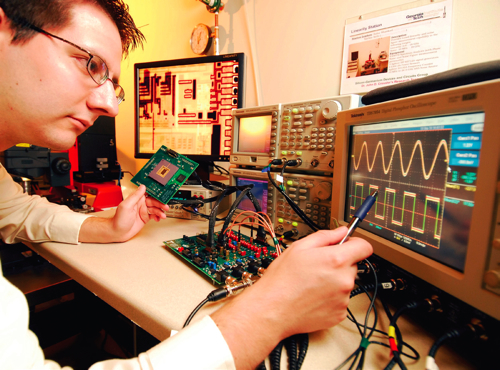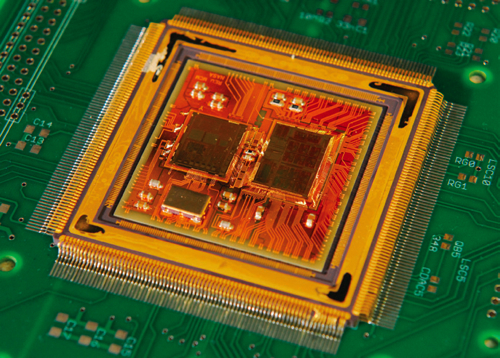A five-year project led by the Georgia Institute of Technology has developed a novel approach to space electronics that could change how space vehicles and instruments are designed. The new capabilities are based on silicon-germanium (SiGe) technology, which can produce electronics that are highly resistant to both wide temperature variations and space radiation.

The $12 million, 63-month project was funded by the National Aeronautics and Space Administration (NASA). In addition to Georgia Tech, the 11-member team included academic researchers from the University of Arkansas, Auburn University, University of Maryland, University of Tennessee and Vanderbilt University. Also involved in the project were BAE Systems, Boeing Co., IBM Corp., Lynguent Inc. and NASA’s Jet Propulsion Laboratory.
“The team’s overall task was to develop an end-to-end solution for NASA—a tested infrastructure that includes everything needed to design and build extreme-environment electronics for space missions,” said John Cressler, a Ken Byers Professor in Georgia Tech’s School of Electrical and Computer Engineering. Cressler served as principal investigator and overall team leader for the project.
SiGe alloys combine silicon, the most common microchip material, with germanium at nanoscale dimensions. The result is a robust material that offers important gains in toughness, speed and flexibility.
That robustness is crucial to silicon-germanium’s ability to function in space without bulky radiation shields or large, power-hungry temperature control devices. Compared to conventional approaches, SiGe electronics can reduce weight, size, complexity, power and cost, as well as increase reliability and adaptability.
“Our team used a mature silicon-germanium technology – IBM’s 0.5 micron SiGe technology – that was not intended to withstand deep-space conditions,” Cressler said. “Without changing the composition of the underlying silicon-germanium transistors, we leveraged SiGe’s natural merits to develop new circuit designs – as well as new approaches to packaging the final circuits – to produce an electronic system that could reliably withstand the conditions of space.”
At the end of the project, the researchers supplied NASA with a suite of modeling tools, circuit designs, packaging technologies and system/subsystem designs, along with guidelines for qualifying those parts for use in space. In addition, the team furnished NASA with a functional prototype – called a silicon-germanium remote electronics unit (REU) 16-channel general-purpose sensor interface. The device was fabricated using silicon-germanium microchips and has been tested successfully in simulated space environments.
Andrew S. Keys, center chief technologist at the Marshall Space Flight Center and NASA program manager, said the now-completed project has moved the task of understanding and modeling silicon-germanium technology to a point where NASA engineers can start using it on actual vehicle designs.
Noted Keys, at best, most electronics conform to military specifications, meaning they function across a temperature range of -55° C to +125° C. But electronics in deep space are typically exposed to far greater temperature ranges, as well as to damaging radiation. The Moon’s surface cycles between +120° C during the lunar day to -180° C at night.
The silicon-germanium electronics developed by the extreme environments team has been shown to function reliably throughout that entire +120° C to -180° C range. It is also highly resistant or immune to various types of radiation.
By eliminating the need for most shielding and special cables, silicon-germanium technology helps reduce the single biggest problem in space launches —weight. Moreover, robust SiGe circuits can be placed wherever designers’ want, which helps eliminate data errors caused by impedance variations in lengthy wiring schemes.
“For instance, the Mars Exploration Rovers, which are no bigger than a golf cart, use several kilometers of cable that lead into a warm box,” Keys said. “If we can move most of those electronics out to where the sensors are on the robot’s extremities, that will reduce cabling, weight, complexity and energy use significantly.”
NASA currently rates the new SiGe electronics at a technology readiness level of six, which means the circuits have been integrated into a subsystem and tested in a relevant environment. The next step, level seven, involves integrating the SiGe circuits into a vehicle for space flight testing. At level eight, a new technology is mature enough to be integrated into a full mission vehicle, and at level nine the technology is used by missions on a regular basis.

BAE Systems’ contribution to the project included providing the basic architecture for the remote electronics unit (REU) sensor interface prototype developed by the team.
The extreme environments team transformed the bulky X-33 design into a miniature sensor interface, using silicon germanium. The resulting SiGe device weighs about 200 grams and requires no temperature or radiation shielding.
“The idea is to make this infrastructure available to all interested parties,” Cressler said. “That way it could be used for any electronics assembly— an instrument, a spacecraft, an orbital platform, lunar-surface applications, Titan missions – wherever it can be helpful.”
Georgia Institute of Technology
www.gatech.edu
::Design World::
Filed Under: Aerospace + defense, Materials • advanced, ELECTRONICS • ELECTRICAL





Tell Us What You Think!